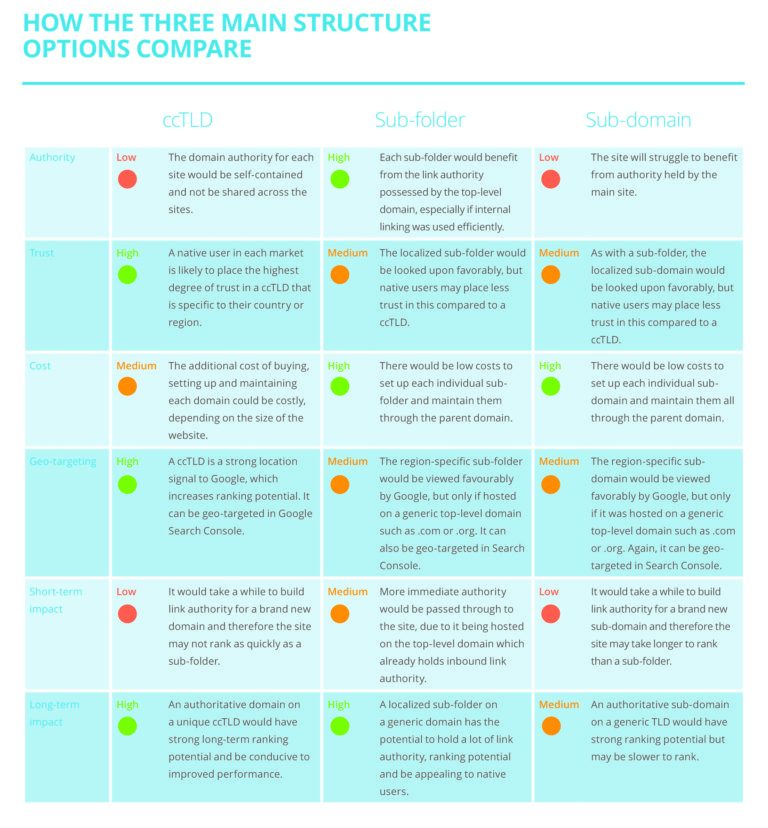
![]() Insights
Insights
Expanding into new global markets costs a lot of time, money and resources, and even the biggest brands are not guaranteed success.
Fortunately, there are several steps you can take to ensure your expansion is a success. It is important not to rush the process, or launch in several markets at once without the necessary prep.
Following these steps will ensure that you launch into the right market, with the right messaging, and that your international website is technically, culturally and linguistically set up for users and search engines so it can perform from day one.
It is crucial that you understand a market before deciding to pour budget into expanding there, as this allows you to identify if there are any opportunities for your brand, and what these opportunities are.
Your research should uncover:
These insights allow you to address your brand’s strengths and weaknesses ahead of launch, as well as create a bespoke digital strategy which is optimized for the audience in that particular market.
Your own website analytics is a great place to start when looking at user interest, as you can identify which countries you are receiving traffic from, as well as how many of these users are converting. High traffic and conversions indicate high interest in that country, making it likely your brand will perform well there.
Another way to test user interest and behavior is to build out landing pages and use PPC to see what click-through rate and conversions are like for the prospective market; these insights can also be used to build out both organic and paid strategies if you do decide to expand.
Once you have identified there is interest in your brand, you will need to understand who your competitors are and how strong the competition is. SemRush is a great tool to identify this information and allow you to begin planning an organic search strategy.
Once you have identified which market to expand into, you’ll need to decide what type of domain to choose from: country code top-level domain (ccTLD), sub-folder, or sub-domain.
Each has advantages and disadvantages, and the option you go for should reflect your budget and resource, as well as short- and long-term business objectives. We run through the considerations you need to take when choosing a domain type here.

It can be all too tempting to automate translation from your home site to a new language, as it is a cost- and time-effective way of translating entire websites. Doing so, however, can actually damage your brand and lead to poor rankings, low clicks, low conversion rates, and consumer mistrust.
Working with translators with little to no knowledge of SEO can also waste time and resource, as translated content is not optimized for search and will need to be re-written in order to rank organically.
The best way to approach translation is to work with mother tongue digital experts who can conduct keyword research, which can then be included in the site translation memory, ensuring all current and future on-site content is optimized for search. This keyword research can be used to guide organic and paid strategies for the local site.
Mother tongue linguists should also be used to write optimized off page copy and build out the site map for translators to ensure translators understand the purpose of the content they are writing; who is the audience, and where are they in the buying funnel?
A common mistake we see with international expansion is the incorrect use of hreflang tags, which can have a detrimental effect on your organic ranking. You can read about the three most common hreflang mistakes and how to fix them in this blog.
Another mistake we see being made when brands expand is setting the same KPIs across every market.
There are many factors that can affect the performance of local sites. For example, well established sites with an existing customer base often benefit from a lower CPA in remarketing campaigns, increased organic visibility, and more brand awareness, all which can lead to more traffic and conversions.
Different search engines, marketplaces and ecommerce platforms may also have a different market share across different countries, which can impact performance. Sales events also vary across different markets – for example, Black Friday is not a key sales driver in some countries. Our international experts have created an international sales event calendar pulling together key sales events from across the globe.
Paid media is a great way of encouraging traffic and conversions to your localized site. However, having ads which perform well does not necessarily mean that your brand will perform well organically, as you may be lacking brand awareness and online visibility in this new market. Improving your website’s visibility is crucial if you are to reduce the amount you spend on advertising, without losing customers.
Content marketing and digital PR is a great way of building brand awareness, highlighting your brand as an industry leader, and earning links to improve your website authority. While creative digital PR campaigns can vary in cost, there is a range of tactics which can be carried out on a small budget.
We’ve created a step by step guide to planning international PR campaigns, which you can read here.
Ensuring that your site has relevant trust signals, such as an on-site privacy policy, cookie policy and safety documentation, can also help search engines to identify that your site is trustworthy and worth ranking.
International expansion is an exciting step for many enterprises. By ensuring that the process is carried out strategically, using industry expertise, native linguists, and data insights, you are setting your business up to successfully launch into new markets.
As an international digital marketing agency with a team of over 30 native linguists that are digital marketing experts, we can help you at every step of the way. Why not get in touch to start your journey?
This blog is part of our wider B2B Playbook that is designed to help B2B businesses with all aspects of their digital marketing from leveraging data, acquiring more traffic, creating assets that resonate and succeeding internationally.
If you’re thinking of expanding into international markets, the international section is for you. Here we review everything you’ll need to take into consideration when going global.

![]() Insights
Insights

![]() Insights
Insights

![]() Insights
Insights